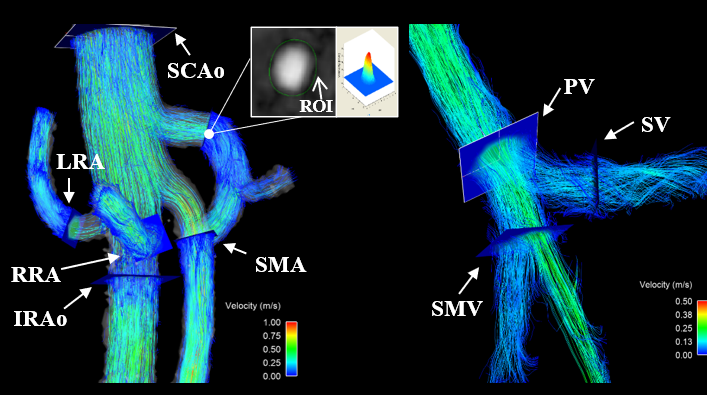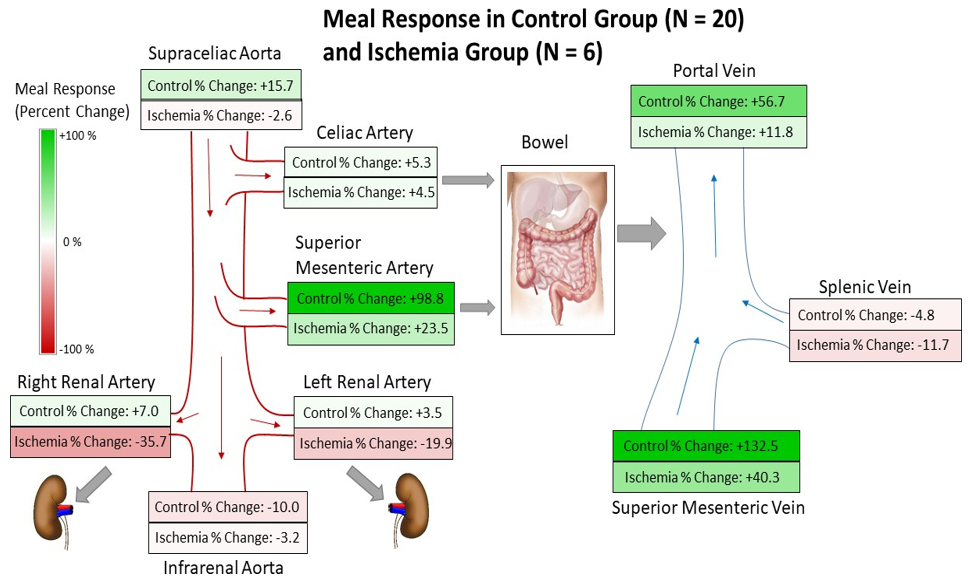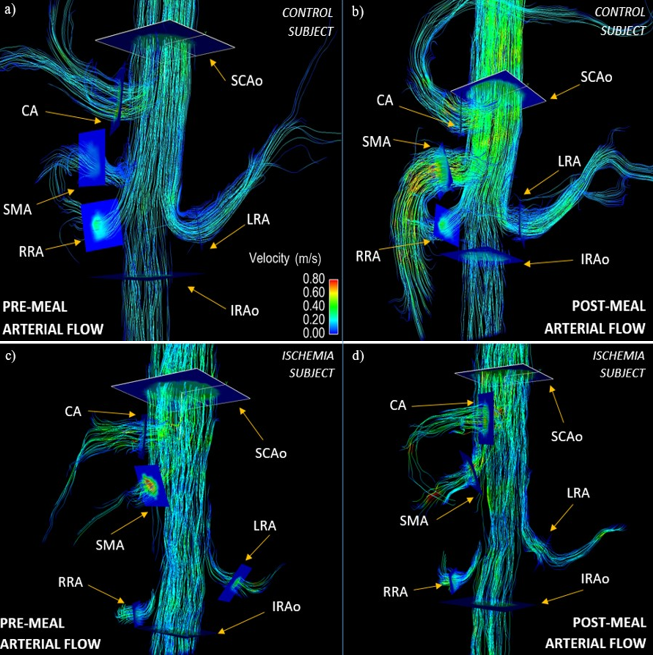Chronic Mesenteric Ischemia
Background
Chronic mesenteric ischemia (CMI) is a disease caused by inadequate blood flow to the intestines, often caused by vessel occlusions in the primary mesenteric vessels. While mesenteric artery stenoses are relatively common in aging populations, CMI is rare because of collateral pathways within the mesenteric vasculature that often compensate for reduced blood flow. This disease becomes particularly symptomatic for patients after eating a meal, because increased blood flow to the intestines is required for proper digestion. In patients with CMI, the normal increase in mesenteric blood flow after meal consumption is stunted causing dull abdominal pain 15-60 minutes after meal ingestion with pain continuing up to 4 hours. This subsequently leads to fear of food, severe weight loss, and can eventually progress to acute-on-chronic mesenteric ischemia which is associated with high mortality. However, the proper diagnosis of CMI is notoriously difficult and requires a high index of clinical suspicion with currently no well-established diagnostic criteria.
As my first project in graduate school, I was tasked with analyzing 4D flow MRI scans before (preprandial) and after a meal (postprandial) in subjects suspected of CMI. This was part of an ongoing study where patients were referred from vascular surgery or gastroenterology and pre/postprandial 4D fow MRI exams were added to the routine clinical workup (with IRB approval and patient consent). For 4D flow analysis, images were reconstructed offline and complex difference angiograms were segmented in Mimics. This data was then exported to Ensight for hemodynamic analysis and time-resolved in-plane vessel segmentation was performed in a customized analysis tool. Flow analysis was performed in 6 arteries: superior mesenteric artery (SMA), celiac artery (CA), supraceliac aorta (SCAo), infrarenal aorta (IRAo), right renal artery (RRA), left renal artery (LRA), as well as 3 veins: superior mesenteric vein (SMV), splenic vein (SV), and portal vein (PV). Patients were subcategorized into positive (CMI+) and negative (CMI-) CMI diagnosis groups based on imaging and clinical findings. Patients were classified as deemed CMI+ if MRA imaging showed significant stenoses (≥50%) in 2 or more primary vessels and if clinical findings strongly suggested CMI. Twenty healthy control subjects underwent the same CMI protocol for comparison.

In total, there were 19 subjects suspected of CMI (6 = CMI+ and 13 = CMI-). In controls and CMI- patients, SCAo, SMA, SMV, and PV flow increased significantly after meal ingestion. No significant flow increases were observed in CMI+ patients. Percent changes in SCAo, SMA, SMV, and PV flow were significantly greater in controls compared to CMI+ patients. Additionally, percent changes in flow in the SCAo, SMV, and PV were significantly greater in CMI- patients compared to CMI+ patients. We also found that there were differences in pulsatility and resistivity in the aorta, SV, and SMV in the CMI+ group, indicating differences in downstream vascular resistance.
4D flow MRI with large volumetric coverage demonstrated significant differences in the redistribution of blood flow in the SCAo, SMA, SMV, and PV in CMI+ patients after a meal challenge. This approach may be useful in the challenging diagnosis of CMI.
Collaborations:
UW Radiology, Liver Imaging Research Program
Abstracts
Poster Presentation
- Roberts, G. S., Francois, C. J., Roldan-Alzate, A., & Wieben, O. Pre and Postprandial Hemodynamics of the Gastroduodenal Artery in Patients Suspected of Chronic Mesenteric Ischemia using 4D Flow MRI. ISMRM 27th Annual Meeting & Exhibition; 2019 May 11; Montreal, QC, Canada. Download
- Roberts, G. S., Francois, C. J., Roldan-Alzate, A., & Wieben, O. Pulsatility and Resistivity Indices in Mesenteric Vasculature in Patients Suspected of Chronic Mesenteric Ischemia using 4D Flow MRI. Joint Annual Meeting ISMRM-ESMRMB; 2019 May 11; Montreal, QC, Canada. Download
- Roberts, G. S., Roldan-Alzate, A., Francois, C. J., & Wieben, O. Non-Invasive Assessment of Mesenteric Hemodynamics with 4D Flow MRI. Joint Annual Meeting ISMRM-ESMRMB; 2018 June 16; Paris, France. Download
Manuscripts
Accepted
Roberts, G. S., François, C. J., Starekova, J., Roldán-Alzate, A., & Wieben, O. (2021). Non-invasive assessment of mesenteric hemodynamics in patients with suspected chronic mesenteric ischemia using 4D flow MRI. Abdominal Radiology (New York), 10.1007/s00261-020-02900-0.
Awards
- 2019 - ISMRM Magna Cum Laude Merit Award; Pulsatility and Resistivity Indices in Mesenteric Vasculature in Patients Suspected of Chronic Mesenteric Ischemia using 4D Flow MRI, ISMRM 2019. Pancreas/GI Poster Session.
- 2018 - ISMRM Summa Cum Laude Merit Award; Non-Invasive Assessment of Mesenteric Hemodynamics with 4D flow MRI, ISMRM 2018. Body: Liver Poster Session.



Leave a Comment
Your email address will not be published. Required fields are marked *